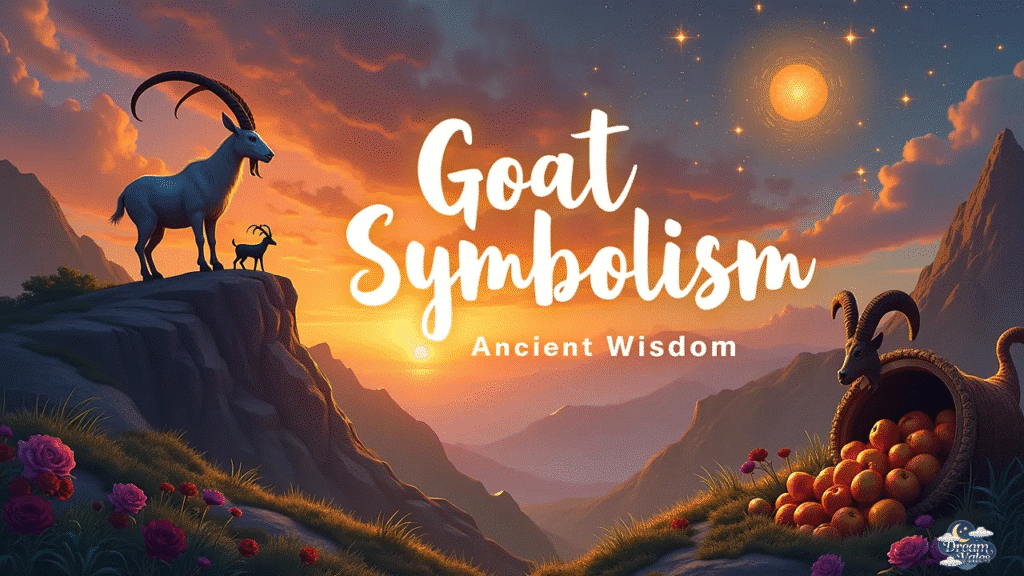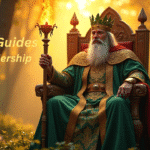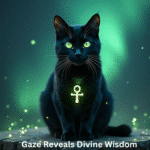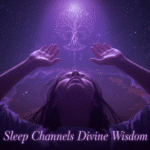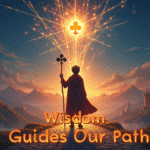The goat has captivated human imagination for millennia, appearing in everything from ancient cave paintings to modern internet memes. These remarkable creatures carry profound symbolic weight across cultures, representing everything from divine fertility to demonic temptation.
Goat symbolism spans across cultures and centuries, representing everything from nourishment and fertility to strength and spiritual significance. These remarkable creatures have evolved from simple farm animals into powerful symbols of abundance, resilience, and divine connection in mythologies, religions, and cultural traditions worldwide.
Their dual nature makes them one of the most complex and fascinating symbols in human consciousness. Understanding goat symbolism requires diving deep into humanity’s oldest stories, religious traditions, and cultural practices.
You’ll discover how these animals became associated with gods and devils, abundance and sacrifice, wisdom and stubbornness. This comprehensive exploration reveals why goats remain powerfully relevant in our modern spiritual landscape.
Ancient Origins of Goat Symbolism
Archaeological evidence shows humans domesticated goats around 10,000 years ago in the Zagros Mountains of Iran. These early relationships weren’t just practical – they were deeply spiritual.
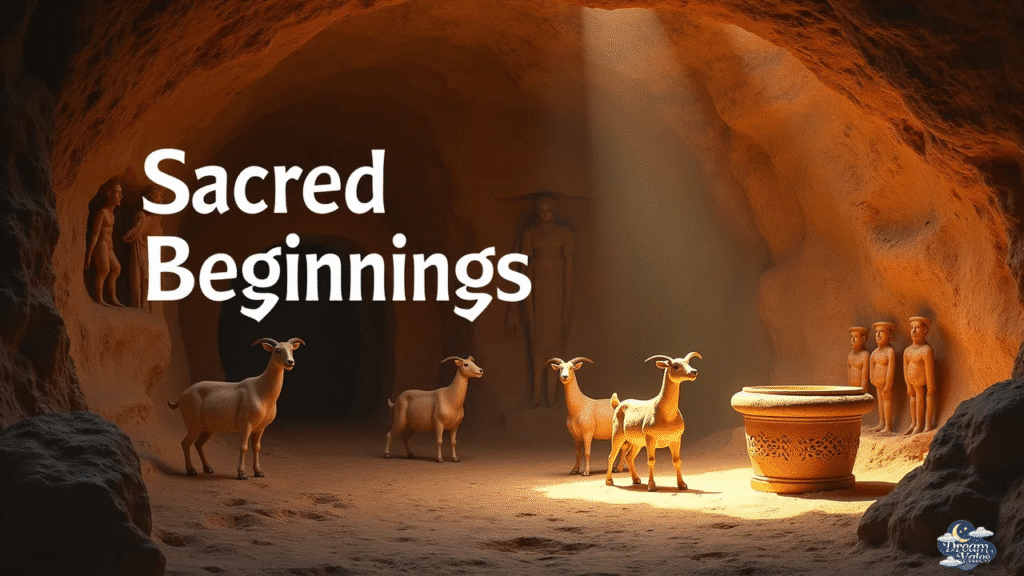
Neolithic cave paintings frequently depict goats alongside human figures, suggesting their symbolic importance predates written history. The connection between humans and goats runs deeper than simple domestication.
Ancient burial sites often contain goat remains alongside human bones, indicating these animals held sacred status. In Çatalhöyük, one of the world’s oldest cities, archaeologists discovered elaborate goat horn installations that likely served ceremonial purposes.
Mesopotamian civilizations elevated goats to divine status. Sumerian fertility goddesses often appeared with goat companions, while Babylonian astronomers named constellation patterns after celestial goats.
The Epic of Gilgamesh mentions sacred goats that provided wisdom to heroes, establishing early literary traditions that would influence cultures for thousands of years. These ancient peoples recognized something profound in goats’ nature – their ability to thrive in harsh environments while providing sustenance to humans.
This practical dependence evolved into spiritual reverence, creating symbolic associations that persist today. The goat became a bridge between the material and spiritual worlds in ancient consciousness.
| Ancient Goat Symbolism | Culture | Time Period | Meaning |
|---|---|---|---|
| Sacred Burial Companion 🐐 | Neolithic | 8000 BCE | Spiritual Guide |
| Fertility Goddess Symbol 🌟 | Sumerian | 4000 BCE | Life Force |
| Celestial Navigation 🌙 | Babylonian | 3000 BCE | Divine Wisdom |
| Hero’s Companion 📜 | Mesopotamian | 2000 BCE | Mystical Aid |
| Temple Offering 🏛️ | Egyptian | 3000 BCE | Divine Communication |
| Mountain Spirit 🏔️ | Anatolian | 6000 BCE | Resilience |
| Harvest Blessing 🌾 | Agricultural | 5000 BCE | Abundance |
| Warrior Totem ⚔️ | Tribal | 4000 BCE | Courage |
Goats in Classical Antiquity
Greek mythology transformed goats into powerful divine symbols. Pan, the goat-god of nature, embodied humanity’s wild, untamed aspects.
His half-goat, half-human form represented the bridge between civilized society and primal instincts. Pan’s pipes created music that could heal or drive listeners mad, reflecting goats’ dual nature in human consciousness.
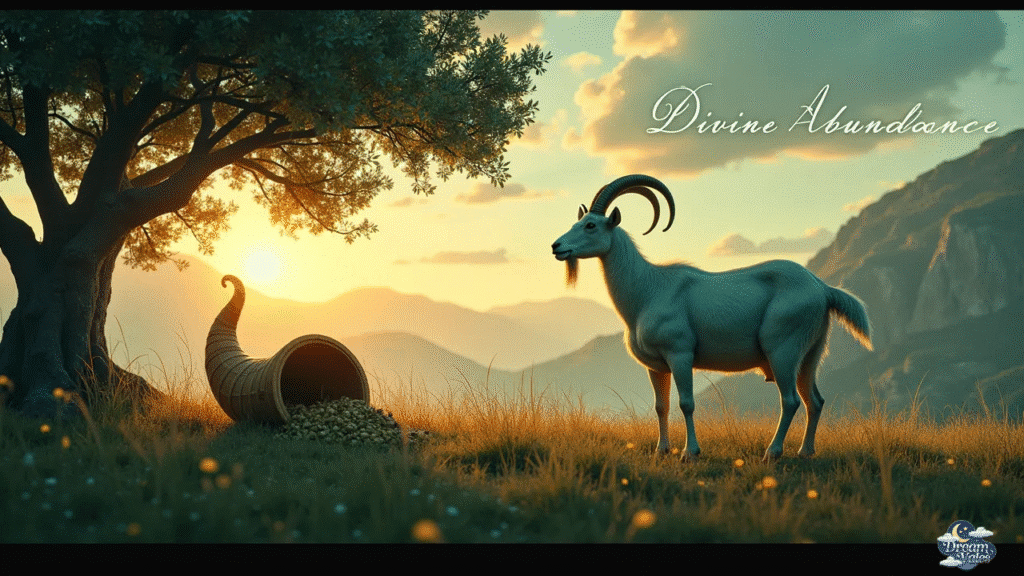
The story of Amalthea reveals another dimension of goat symbolism. This divine goat nursed the infant Zeus, providing nourishment that enabled him to overthrow the Titans.
When Amalthea died, Zeus crafted her hide into the Aegis shield and transformed her horn into the cornucopia – the horn of plenty that provides endless abundance. This transformation established goats as symbols of divine providence and infinite giving.
Roman culture adopted and adapted Greek goat symbolism. Faunus, their equivalent of Pan, presided over agriculture and livestock.
Roman festivals like Lupercalia featured goat sacrifices intended to ensure fertility and protect crops. These practices demonstrate how goats became integral to ancient understanding of seasonal cycles and agricultural success.
The constellation Capricornus preserves ancient goat symbolism in our modern sky. This sea-goat hybrid represents the mythical creature that saved the gods from the monster Typhon.
The story illustrates goats’ role as protectors and guides during dangerous transformations. Ancient peoples saw in this constellation a reminder of the goat’s power to navigate between different worlds and states of being.
Sacred Symbolism Across World Religions
Christianity presents perhaps the most complex relationship with goat symbolism. The Bible frequently mentions goats, often in challenging contexts.
Jesus spoke of separating sheep from goats at judgment, creating lasting associations between goats and spiritual rebellion. However, this interpretation oversimplifies biblical goat symbolism.
Old Testament traditions reveal positive goat associations. The Day of Atonement ceremony required two goats – one sacrificed to God, another sent into the wilderness carrying the people’s sins.

This scapegoat ritual demonstrates goats’ role in spiritual purification and community healing. The practice influenced Western culture’s understanding of taking responsibility for collective problems.
Medieval Christianity unfortunately demonized goats, associating them with Satan and witchcraft. This period saw goat imagery become synonymous with evil, creating negative stereotypes that persist today.
However, modern Christian scholarship recognizes these associations as cultural additions rather than biblical teachings. Early Christian art sometimes depicted Christ as a goat herder, emphasizing his role as protector of the marginalized.
Some interpretations suggest goats represented converts from paganism, requiring extra care and attention. This perspective reveals Christianity’s more nuanced relationship with goat symbolism.
| Religious Goat Symbolism | Tradition | Context | Significance |
|---|---|---|---|
| Scapegoat Ritual 🕊️ | Judaism | Yom Kippur | Atonement |
| Divine Nourishment 🍼 | Christianity | Early Art | Spiritual Care |
| Sacrifice Offering 🔥 | Islam | Eid al-Adha | Devotion |
| Temple Guardian 🏯 | Hinduism | Daksha | Protection |
| Fertility Blessing 👶 | Vedic | Rituals | Life Force |
| Transformation Symbol 🦋 | Buddhism | Tibetan | Change |
| Mountain Wisdom 🏔️ | Tibetan | Buddhism | Spiritual Height |
| Sacred Messenger 📿 | Various | Shamanic | Divine Communication |
Eastern Religious Traditions
Hindu traditions present goats as complex spiritual symbols. Daksha, one of the Prajapatis or divine creators, possessed a goat’s head after Shiva’s anger destroyed his human form.
This transformation story illustrates themes of death, rebirth, and spiritual evolution. Daksha’s goat form allowed him to continue his creative work, suggesting goats represent adaptability and resilience.
Vedic fire sacrifices often included goats, connecting these animals to Agni, the fire god. These rituals weren’t simply about animal sacrifice – they represented the transformation of material offerings into spiritual energy.
The goat’s role in these ceremonies emphasized its function as a bridge between physical and spiritual realms. Modern Hindu practices continue goat symbolism, though often controversially.
Some temples still perform goat sacrifices during festivals like Dashain, believing these offerings appease fierce deities. However, many Hindu communities have replaced animal sacrifice with symbolic alternatives, reflecting evolving spiritual understanding.
Buddhist perspectives on goat symbolism emphasize compassion and interconnectedness. Tibetan Buddhist art sometimes features goats as symbols of persistence and sure-footedness on the spiritual path.
The mountain goat’s ability to navigate treacherous terrain becomes a metaphor for navigating life’s challenges with wisdom and determination. These teachings emphasize the importance of maintaining balance while pursuing spiritual goals.
You may also like to read: Symbols of Harmony in Arts and Culture
European Folk Traditions
Celtic cultures developed rich goat mythology that influenced European folklore for centuries. Cernunnos, the horned god, often appeared with goat features, representing fertility, abundance, and the wild masculine principle.
Celtic druids considered goats sacred animals that could access otherworldly wisdom. Irish folklore describes supernatural goats that appeared during liminal times – dawn, dusk, and seasonal transitions.
These phantom goats often served as omens, warning of impending changes or guiding lost travelers to safety. The banshee goat tradition suggests these animals could traverse spiritual boundaries invisible to humans.
Norse mythology presents goats as divine companions. Thor’s chariot was pulled by two goats, Tanngrisnir and Tanngnjóstr, whose names mean “teeth-barer” and “teeth-grinder.”
These goats possessed magical properties – Thor could eat them for sustenance, then resurrect them with his hammer Mjolnir. This story illustrates themes of sacrifice, renewal, and divine provision.
Germanic traditions often featured goats in seasonal celebrations. The Yule Goat became a Christmas symbol, representing the spirit of giving and seasonal abundance.
This tradition survives today in Scandinavian countries where straw goats decorate homes during winter holidays. The practice demonstrates how ancient goat symbolism adapts to modern contexts while maintaining essential meaning.
Indigenous Wisdom Traditions
Native American cultures developed sophisticated goat symbolism, particularly among tribes in mountainous regions. The mountain goat clan totems taught lessons about persistence, courage, and maintaining balance in dangerous situations.
These animals represented the ability to find secure footing even in life’s most challenging circumstances. Pueblo pottery frequently features goat imagery, often depicting these animals as rain spirits or fertility symbols.
The goat’s association with mountain heights connected them to cloud formation and precipitation – essential for agricultural societies in arid regions. These artistic traditions preserve ancient understanding of goats’ spiritual significance.
Many Native American stories feature goats as trickster figures or wise teachers. These tales often describe goats helping humans learn important lessons about cooperation, resource management, and respect for nature.
The stories emphasize goats’ intelligence and their role as mediators between human and natural worlds. African cultures developed diverse goat traditions reflecting local environments and needs.
West African trickster stories often featured clever goats outwitting larger predators, teaching lessons about using intelligence rather than brute force. These tales influenced African American folklore, where goat characters continued representing quick thinking and survival skills.
Ethiopian highland cultures particularly revered goats for their ability to thrive in harsh mountain conditions. These traditions viewed goats as symbols of endurance and the capacity to find nourishment in seemingly barren environments.
Asian Cultural Perspectives
Chinese astrology assigns specific personality traits to people born during the Year of the Goat. These individuals are considered gentle, creative, and intuitive, but sometimes lacking in confidence.
The Chinese goat year occurs every twelve years, with the next one scheduled for 2027. Traditional Chinese medicine also utilizes goat products for various therapeutic purposes.
The Chinese zodiac goat represents the eighth position, associated with artistic talent and peaceful nature. Ancient Chinese texts describe goats as symbols of righteousness and filial piety.
Confucian scholars often used goat behavior to illustrate proper social conduct and family relationships. Japanese Shinto traditions feature goats as guardians of mountain shrines.
These animals are believed to possess supernatural abilities to detect evil spirits and protect sacred spaces. Some Japanese temples keep goats as living symbols of divine protection, continuing ancient practices that honor these animals’ spiritual significance.
Modern Japanese culture has embraced goat symbolism in contemporary art forms. Manga and anime frequently feature goat characters representing wisdom, stubbornness, or otherworldly knowledge.
These modern interpretations blend traditional symbolism with contemporary storytelling techniques. Korean shamanic traditions also incorporate goat imagery in rituals designed to ensure mountain safety and agricultural success.
| Asian Goat Symbolism | Culture | Characteristic | Modern Application |
|---|---|---|---|
| Artistic Nature 🎨 | Chinese | Creativity | Design Inspiration |
| Gentle Spirit 🕊️ | Chinese | Peacemaking | Conflict Resolution |
| Mountain Guardian ⛰️ | Japanese | Protection | Shrine Keeping |
| Righteous Behavior ⚖️ | Confucian | Morality | Ethical Teaching |
| Supernatural Sight 👁️ | Shinto | Spirit Detection | Spiritual Practice |
| Filial Devotion 👨👩👧👦 | Chinese | Family Loyalty | Relationship Guidance |
| Mystical Wisdom 🔮 | Japanese | Ancient Knowledge | Spiritual Seeking |
| Seasonal Harmony 🌸 | Japanese | Natural Balance | Environmental Awareness |
Fertility and Life Force
Goats’ remarkable reproductive capabilities made them universal symbols of fertility and life force. Female goats typically give birth to twins or triplets, while males remain sexually active year-round.
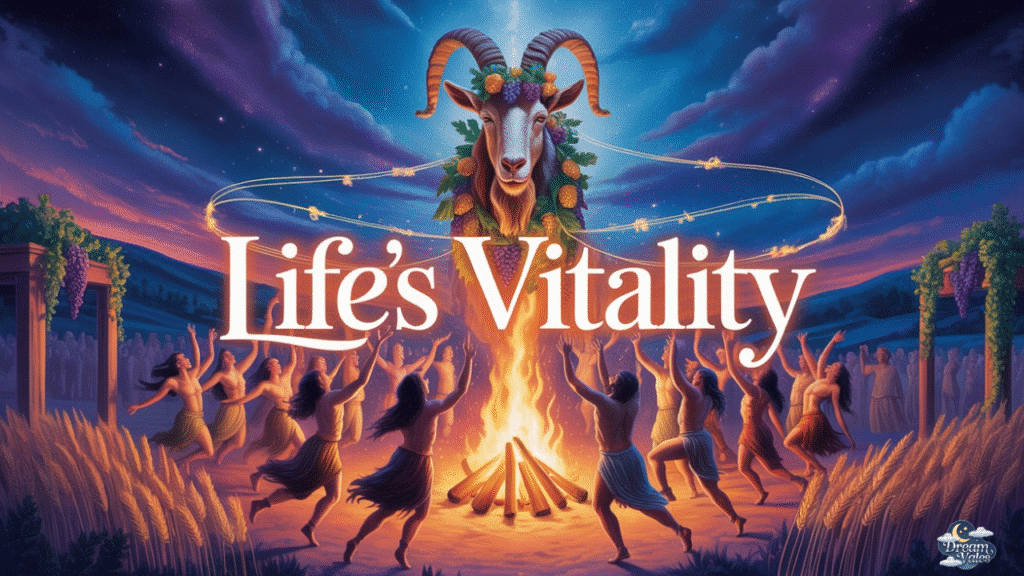
These biological facts created powerful symbolic associations with abundance, creativity, and generative power across cultures worldwide. Ancient fertility rituals often centered around goat imagery and sacrifice.
Greek Dionysiac festivals featured goat-skin wearing participants who enacted fertility dramas. These ceremonies weren’t merely symbolic – communities believed they actually enhanced agricultural productivity and human reproduction through sympathetic magic.
The connection between goats and human sexuality appears throughout world mythology. Satyrs, Pan’s followers, possessed goat features and insatiable sexual appetites.
While modern interpretations sometimes view these figures as crude, ancient cultures understood them as representations of healthy, natural sexual energy essential for life continuation. Contemporary spiritual practices sometimes incorporate goat symbolism for fertility work.
Modern witches and neo-pagans may invoke goat spirits during rituals intended to enhance creativity, sexuality, or manifestation abilities. These practices attempt to reconnect with ancient wisdom about goats’ generative power.
The goat’s association with spring festivals and seasonal renewal reinforces its connection to life force and regeneration. Many cultures timed goat-related ceremonies to coincide with agricultural planting seasons.
Nourishment and Abundance
Goat milk provided essential nutrition for ancient civilizations, particularly in regions where cattle couldn’t survive. This practical dependence created symbolic associations between goats and divine nourishment.
Many cultures believed goat milk possessed magical properties that could heal illness and grant supernatural strength. The cornucopia legend directly connects goats to abundance symbolism.
When Zeus transformed Amalthea’s horn into the horn of plenty, he created one of Western culture’s most enduring abundance symbols. This mythological object provides endless food, representing the universe’s infinite capacity to support life.
Archaeological evidence suggests ancient peoples valued goat products beyond simple nutrition. Goat hair provided textiles, bones became tools, and horns served as containers or musical instruments.
This complete utilization elevated goats to symbols of resourcefulness and sustainable living. Modern environmental movements sometimes reference goat symbolism when discussing sustainable agriculture.
Goats’ ability to thrive on marginal land while providing multiple products makes them symbols of ecological wisdom and responsible resource management. Their browsing habits can actually improve degraded landscapes by controlling invasive vegetation.
Contemporary homesteading movements often embrace goats as symbols of self-sufficiency and connection to traditional ways of life. These practices reflect ancient understanding of goats as providers of abundance through careful stewardship.
If you’re interested, check out: Symbolism of The Star Across Arts and Cultures
Strength and Tenacity
Mountain goats demonstrate extraordinary physical capabilities that inspired symbolic meanings across cultures. These animals can climb nearly vertical cliff faces, leap across dangerous chasms, and survive in extreme weather conditions.

Their remarkable abilities made them natural symbols of perseverance and overcoming obstacles. The physics behind goat climbing reveals why these animals became symbols of achievement.
Their hooves contain soft pads that provide exceptional grip, while their low center of gravity enables incredible balance. These adaptations allow goats to reach places other animals cannot access, creating metaphors for achieving seemingly impossible goals.
Native American cultures particularly valued mountain goat symbolism for its lessons about persistence and courage. Warriors sought goat spirit guidance before dangerous missions, believing these animals could provide supernatural climbing abilities and sure-footedness in treacherous situations.
Modern motivational speakers sometimes reference goat symbolism when discussing goal achievement and persistence. The phrase “greatest of all time” abbreviated as GOAT has become popular in sports and business contexts, connecting contemporary success with ancient goat symbolism.
The goat’s reputation for stubbornness, while sometimes viewed negatively, actually represents valuable persistence and determination. This quality becomes positive when directed toward worthy goals and meaningful achievements.
Professional athletes often embody goat-like qualities of relentless training, mental toughness, and the ability to perform under pressure. These characteristics reflect the mountain goat’s natural survival strategies adapted to human endeavors.
| Goat Strength Symbolism | Physical Trait | Symbolic Meaning | Modern Application |
|---|---|---|---|
| Cliff Climbing 🧗 | Specialized Hooves | Overcoming Obstacles | Goal Achievement |
| Balance Mastery ⚖️ | Low Center Gravity | Stability | Life Balance |
| Weather Endurance 🌨️ | Thick Coat | Resilience | Stress Management |
| Jumping Ability 🦘 | Powerful Legs | Taking Leaps | Risk Taking |
| Sure-footedness 👣 | Flexible Hooves | Confidence | Decision Making |
| High Altitude Living 🏔️ | Efficient Lungs | Aspiration | Career Advancement |
| Territorial Defense 🛡️ | Head Butting | Standing Ground | Boundary Setting |
| Foraging Skills 🌿 | Adaptable Diet | Resourcefulness | Problem Solving |
Sacrifice and Transformation
Goat sacrifice appears in numerous ancient cultures, representing themes of transformation, atonement, and divine communication. These practices weren’t simply about killing animals – they involved complex rituals designed to transfer spiritual energy between human and divine realms.
The goat’s role in these ceremonies emphasized its function as a bridge between worlds. The biblical scapegoat ritual demonstrates sophisticated understanding of collective responsibility and spiritual cleansing.
The high priest would symbolically transfer the community’s sins onto a goat, then send it into the wilderness. This practice acknowledged that individual problems often reflect community-wide issues requiring collective healing.
Archaeological evidence reveals goat sacrifice occurred across diverse cultures – from Celtic druids to Aztec priests. These independent developments suggest something fundamental about goats made them suitable for sacrificial purposes.
Their intelligence and social nature may have made them effective spiritual intermediaries. Modern interpretations of sacrifice symbolism focus on voluntary transformation rather than literal killing.
Contemporary spiritual practitioners might “sacrifice” old habits, limiting beliefs, or destructive patterns, using goat symbolism to represent the courage required for genuine change. The transformation aspect of sacrifice remains relevant in personal development work.
Many modern rituals involve symbolic offerings that honor the ancient understanding of sacrifice while respecting contemporary ethical standards. These practices maintain the essential meaning while adapting to evolved consciousness.
You might find this interesting: 17 Symbols of Forgiveness Around the World
Capricorn and Celestial Connections
The constellation Capricornus preserves ancient goat symbolism in our modern sky. This sea-goat hybrid represents Pricus, a mythical creature who could manipulate time and communicate with the gods.
The story illustrates goats’ association with temporal wisdom and divine guidance. Astrological Capricorn traits directly reflect goat symbolism – ambition, persistence, practical wisdom, and the ability to climb steadily toward goals.
People born under this sign often exhibit goat-like characteristics: determination, resourcefulness, and the capacity to thrive in challenging environments. Ancient Babylonian astronomers originally identified this constellation, associating it with Enki, their god of wisdom and water.
The goat-fish hybrid symbolized the ability to navigate both earthly and celestial realms, representing advanced spiritual consciousness. Modern astrology continues emphasizing Capricorn’s connection to achievement and leadership.
The winter solstice occurs during Capricorn season, linking this sign to themes of renewal and the gradual return of light. This timing reinforces goats’ association with persistence through difficult periods.
Capricorn energy teaches the value of patient, methodical progress toward long-term goals. The mountain goat’s climbing strategy mirrors this approach – careful placement of each step, testing stability before committing full weight.
Contemporary astrologers often emphasize Capricorn’s earth sign qualities, connecting it to practical manifestation and material world mastery. These interpretations maintain ancient goat symbolism while addressing modern concerns about achievement and success.
Occult and Esoteric Traditions
The Baphomet symbol, often associated with occult traditions, features goat imagery that frequently causes misunderstanding. This figure represents the union of opposites – male and female, human and animal, earthly and divine.
Rather than promoting evil, Baphomet symbolizes the integration of all aspects of existence. Medieval witch trials often mentioned goat familiars, supernatural animals that allegedly assisted practitioners of magic.
While these accounts likely reflect persecution rather than reality, they demonstrate goats’ continued association with otherworldly knowledge and supernatural abilities. Modern occult traditions sometimes incorporate goat symbolism for its associations with natural wisdom and instinctual knowledge.
These practices attempt to reclaim positive aspects of goat symbolism that were distorted during periods of religious persecution. Aleister Crowley’s writings frequently reference goat symbolism, particularly in relation to the Greek god Pan.
Crowley viewed Pan as a symbol of natural instinct and creative energy that civilized society had unfortunately suppressed. His interpretations influenced modern pagan and occult movements.
Contemporary witchcraft traditions often honor the horned god archetype, which frequently appears with goat features. These practices emphasize connection to natural cycles, personal empowerment, and authentic self-expression.
The goat’s association with untamed nature makes it attractive to spiritual paths that emphasize individual sovereignty and direct experience over institutional authority. These traditions view goat symbolism as representing spiritual liberation and authentic power.
Contemporary Goat Symbolism
Internet culture has transformed goat symbolism through the GOAT acronym – Greatest Of All Time. This usage celebrates exceptional achievement and excellence, connecting contemporary success with ancient goat symbolism.
Sports figures, musicians, and business leaders now wear the GOAT title as a badge of supreme accomplishment. Viral goat videos demonstrate these animals’ continued ability to captivate human attention.
Fainting goats, climbing goats, and screaming goats have become internet sensations, revealing our ongoing fascination with goat behavior. These videos often highlight goats’ intelligence, playfulness, and individual personalities.
Environmental movements sometimes adopt goat symbolism for sustainable agriculture and land management. Goats’ ability to clear invasive vegetation while providing valuable products makes them symbols of ecological balance and practical environmentalism.
Modern spiritual movements often incorporate goat symbolism for its associations with authenticity and natural wisdom. New Age practitioners may invoke goat spirits for guidance about following instincts, maintaining balance, and persevering through challenges.
The craft brewing industry has embraced goat symbolism, with numerous breweries featuring goat names and imagery. This trend reflects goats’ association with rebellion, independence, and unconventional approaches.
Contemporary fashion sometimes incorporates goat motifs, particularly in outdoor and adventure gear branding. These applications connect modern activities with ancient symbols of endurance and mountain mastery.
| Modern Goat Applications | Context | Symbolism | Cultural Impact |
|---|---|---|---|
| GOAT Acronym 🏆 | Sports/Entertainment | Excellence | Achievement Culture |
| Viral Videos 📱 | Social Media | Entertainment | Digital Connection |
| Land Management 🌱 | Agriculture | Sustainability | Environmental Care |
| Yoga Poses 🧘 | Fitness | Balance | Mind-Body Practice |
| Craft Beer Names 🍺 | Marketing | Rebelliousness | Brand Identity |
| Mountain Climbing 🏔️ | Recreation | Adventure | Personal Challenge |
| Petting Zoos 🐐 | Education | Gentle Nature | Child Development |
| Cheese Production 🧀 | Culinary | Quality | Artisan Culture |
The Inner Wild Child
Goat symbolism invites you to embrace your untamed authentic self – the part of you that refuses to be completely domesticated by social expectations. This inner wild child represents your creative impulses, instinctual wisdom, and natural spontaneity that civilization often suppresses.
Pan’s half-goat nature symbolizes the healthy integration of civilized and wild aspects within human personality. Rather than completely abandoning social norms, this integration allows you to access natural instincts while maintaining appropriate boundaries.
The goal isn’t chaos but conscious wildness. Many people discover their inner wild child through creative expression, physical challenges, or spiritual practices.
Dance, art, music, and movement can awaken goat-like energy that feels both freeing and authentic. These activities help you reconnect with natural rhythms often lost in modern life.
Embracing your wild child requires courage to disappoint others’ expectations while staying true to your authentic nature. Goats don’t seek approval – they follow their instincts toward what nourishes and sustains them.
This spiritual lesson encourages you to trust your inner guidance rather than external validation. The wild child aspect doesn’t mean becoming irresponsible or destructive, but rather honoring your genuine impulses and creative expressions.
Modern psychology recognizes the importance of maintaining connection to spontaneous, playful aspects of personality for mental health and creativity. Goat symbolism provides a framework for understanding this integration process.
Continue on your article: Wind Symbolism Across Cultures and Religions Around The World
The Sacred Rebel
Goat symbolism teaches the art of sacred rebellion – questioning authority while maintaining wisdom and compassion. Unlike destructive rebellion that simply opposes everything, sacred rebellion carefully examines which rules serve life and which limit authentic expression.
Throughout history, goats have represented the outsider perspective that challenges conventional thinking. This role requires both courage and discernment – the ability to stand apart from group consensus while offering constructive alternatives.
Sacred rebels don’t destroy merely to destroy but to create space for new possibilities. The goat’s association with mountain climbing provides perfect metaphor for sacred rebellion.
Climbing requires leaving familiar ground and taking calculated risks to reach new heights. Similarly, questioning established systems requires courage to leave comfortable conformity and explore unexplored territories.
Modern sacred rebels might challenge workplace hierarchies, social inequalities, or spiritual dogmas that limit human potential. They use goat-like persistence and sure-footedness to navigate resistance while maintaining focus on positive transformation rather than mere opposition.
The sacred rebel archetype appears throughout history in figures who challenged unjust systems while maintaining ethical principles. These individuals embody goat-like qualities of independence, courage, and unwillingness to compromise essential values.
Contemporary movements for social justice, environmental protection, and spiritual freedom often draw upon sacred rebel energy. Participants channel goat symbolism to maintain persistence in the face of institutional resistance.
Recognizing Goat Symbolism in Your Life
Goat dreams often indicate periods of climbing toward personal goals or navigating challenging terrain in your life. Dreaming of mountain goats might suggest you need to develop better balance between ambition and patience.
Seeing goats in dreams could also represent aspects of yourself that feel wild or untamed. Synchronistic goat encounters in daily life might signal important messages about persistence, authenticity, or the need to trust your instincts.
These experiences often occur during transition periods when you’re climbing toward new levels of personal development. Pay attention to your emotional responses when encountering goat imagery or real goats.
Strong reactions – positive or negative – might indicate important symbolic messages. Your subconscious often uses animal symbolism to communicate insights about your spiritual journey.
Meditation with goat imagery can help you access qualities like determination, balance, and natural wisdom. Visualizing yourself with goat-like abilities to climb difficult terrain might provide inspiration for overcoming current challenges in your life.
Some people report feeling particularly drawn to goat imagery during periods of major life transitions or when facing seemingly impossible obstacles. These attractions often reflect unconscious recognition of needed qualities for personal growth.
Keeping a dream journal can help you track patterns in goat symbolism appearances and their relationship to your waking life circumstances. This practice develops sensitivity to symbolic communication from your deeper wisdom.
| Goat Dream Meanings | Dream Scenario | Possible Interpretation | Action Guidance |
|---|---|---|---|
| Climbing Goat 🧗 | Ascending Mountains | Goal Achievement | Maintain Persistence |
| Feeding Goat 🌿 | Nurturing Animal | Self-Care Needed | Tend Your Needs |
| Wild Goat 🏔️ | Untamed Behavior | Embrace Authenticity | Trust Instincts |
| Baby Goat 👶 | Kid Appearance | New Beginnings | Nurture Growth |
| Goat Herd 👥 | Multiple Animals | Community Support | Value Relationships |
| Talking Goat 🗣️ | Speaking Animal | Inner Wisdom | Listen Within |
| Black Goat 🖤 | Dark Colored | Shadow Work | Face Hidden Aspects |
| White Goat 🤍 | Light Colored | Spiritual Purity | Seek Higher Truth |
Practical Applications
Harnessing goat energy for personal growth requires developing similar qualities – persistence, balance, and the courage to climb toward your goals despite obstacles. Start by identifying your personal mountains – the challenges that seem impossible but call to your deepest aspirations.
Like goats testing each foothold before committing their weight, practice careful evaluation of opportunities and risks. This doesn’t mean avoiding all risks but rather taking calculated chances that align with your authentic goals and values.
Develop your balance by practicing activities that require physical and mental coordination. Rock climbing, balance beam work, or even standing on one foot can help you embody goat-like stability and confidence in challenging situations.
Create personal rituals that honor goat symbolism while respecting ethical boundaries. This might involve mountain hiking, working with goat imagery in art or meditation, or simply spending time observing goats if you have access to them.
Consider incorporating goat-inspired practices into your daily routine. Morning affirmations about persistence and sure-footedness can help you maintain goat-like determination throughout challenging days.
Study the behavior of actual goats to understand their natural wisdom. Notice how they carefully select footing, maintain awareness of their environment, and support each other in herds while maintaining individual independence.
Physical exercise that mimics goat movements – climbing, balancing, jumping – can help you embody these qualities on a cellular level. Many yoga traditions include poses inspired by animal movements for precisely this reason.
Living with Goat Energy
Integrating goat symbolism into daily life means developing comfort with being different, persistent in pursuing authentic goals, and willing to explore territories others consider impossible. This integration process requires patience and self-compassion as you develop new ways of being.
Start small by practicing goat-like qualities in low-stakes situations. Notice opportunities to exercise persistence, authenticity, or careful risk-taking in your everyday interactions and decisions.
Goat energy particularly supports creative endeavors and entrepreneurial activities. These animals’ independence and resourcefulness translate well to innovative projects and unconventional career paths.
Consider how goat symbolism might inform your relationship patterns. Goats balance individual autonomy with herd loyalty, offering lessons about maintaining personal identity within committed relationships.
Environmental consciousness aligns naturally with goat symbolism. These animals’ ability to thrive while improving landscapes provides inspiration for sustainable living practices and ecological awareness.
Seasonal celebrations can incorporate goat symbolism, particularly during spring festivals that honor fertility and new growth. Winter observances might focus on goat-like persistence through difficult periods.
Community involvement often benefits from goat energy – the willingness to challenge systems that don’t serve everyone while maintaining commitment to collective wellbeing. This balance between individual authenticity and community responsibility reflects mature goat symbolism.
| Seasonal Goat Practices | Season | Focus | Activities |
|---|---|---|---|
| Spring Awakening 🌱 | March-May | New Growth | Planting Gardens |
| Summer Climbing 🏔️ | June-August | Achievement | Mountain Hiking |
| Autumn Harvest 🍂 | September-November | Abundance | Gratitude Practices |
| Winter Persistence ❄️ | December-February | Endurance | Indoor Meditation |
| Solstice Celebration 🌞 | December 21 | Renewal | Light Ceremonies |
| Equinox Balance ⚖️ | March/September | Harmony | Balance Exercises |
| Full Moon Reflection 🌕 | Monthly | Insight | Contemplation |
| New Moon Intention 🌑 | Monthly | Planning | Goal Setting |
The Enduring Power of Goat Symbolism
Goat symbolism endures because these animals embody contradictions that reflect human complexity. They’re simultaneously wild and domestic, sacred and profane, gentle and stubborn.
This multifaceted nature makes goats perfect mirrors for human psychological and spiritual development. The goat’s ability to thrive in marginal environments while providing essential resources makes them symbols of resilience and resourcefulness.
In our challenging modern world, these qualities become increasingly valuable for personal and collective survival. Contemporary spiritual seekers find goat symbolism particularly relevant for its emphasis on authentic self-expression and the courage to follow unconventional paths.
In a world that often demands conformity, goat energy provides inspiration for maintaining individual integrity while contributing to community welfare. Your personal journey with goat wisdom might involve developing greater persistence, learning to trust your instincts, or finding the courage to climb toward goals that others consider impossible.
These animals teach that the seemingly impossible becomes possible through patient, persistent effort combined with sure-footed wisdom. The goat’s message remains constant across cultures and centuries – trust your ability to find solid footing even in the most challenging circumstances.
Maintain balance between your wild and civilized natures, and never stop climbing toward your highest aspirations. In embracing goat symbolism, you connect with ancient wisdom while developing practical skills for modern life success.
The integration of goat energy into contemporary life offers pathways for authentic living that honors both individual needs and collective responsibility. This balance becomes increasingly important as humanity faces global challenges requiring both personal transformation and community cooperation.

